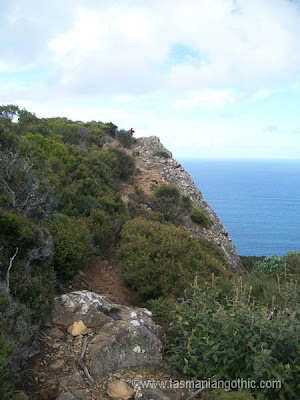My mother's cat woke me, as cats do, this morning. It had been sleeping on the end of my bed and left a generous layering of ginger cat-hair on my black dressing gown. I think it is trying to move into our house and
 sometimes I begin to think it's a bit of a nuisance. I don't need a cat. And, right at the moment, I don't need any more books, either.
sometimes I begin to think it's a bit of a nuisance. I don't need a cat. And, right at the moment, I don't need any more books, either.But Bertie got me out of bed early enough to frock up and go off to Lenah Valley to attend the launch of The Adventures of Jane Franklin, A Victorian Lady Adventurer by Alison Alexander and I came home with another book.
There
are some things "everyone knows" about Jane Franklin.
- Jane Franklin came to Tasmania in 1837 as wife of the new Governor, John Franklin. She worked to protect convict women from predatory masters, which upset both the women and the men, and she instigated various other reforms restricting abuses of power. She was a very determined, smart lady and the Governor more or less did what she told him to, which roused mutterings of "petticoat government" and a good deal of resentment.
- She hated snakes and almost went broke when she offered a "bounty" of a shilling a snake (dead, of course); there were plenty of people ready to take advantage of her offer.
 She
was extremely interested in science and a firm believer in education
and established a botanical garden on her property, Ancanthe,
at Lenah Valley, on the outskirts of Hobart. Emphasis was on
Tasmanian plants, and she had a museum built in classical Greek style
to house a collection of specimens from all over the island.
She
was extremely interested in science and a firm believer in education
and established a botanical garden on her property, Ancanthe,
at Lenah Valley, on the outskirts of Hobart. Emphasis was on
Tasmanian plants, and she had a museum built in classical Greek style
to house a collection of specimens from all over the island.- She adopted an aboriginal girl called Mathinna and had her portrait painted. It is frequently reproduced these days.
- She climbed Mount Wellington and she travelled overland to the West Coast with her husband, her maid and a small party of convicts who carried her on a chair.
- Eventually the Franklins were recalled to England. Sir John went off to discover the Northwest Passage across Canada and vanished, after which Jane spent many years trying to find out what had happened to him.
 |
| the Chair with which Lady Franklin travelled to the west coast - a rather underexposed photo I snapped illegally in the Tasmanian Museum many, many years ago. |
 |
| Alison's husband brought along a modern reproduction of Lady Franklin's chair. Rides were offered, but I didn't see any takers |
 |
| Alison Alexander and Mrs Underwood |
Mrs
Underwood's speech was splendid; she had obviously taken the time to
read the book carefully. She had also read one of Alison's earlier books –
Governors' Ladies, which she said she had found most useful .
. .
If you want to read the full speech, the helpful people at Government House have it up on their website, but you will miss Mrs
Underwood's lively, informed and amusing delivery.
You
can see some much better photos than the one I took, here.
It is obvious there is a great deal more to know about Jane Franklin and no doubt many of the things "everyone knows" are not at all what really happened. Alison Alexander is a meticulous historian and a very good writer, and I can thoroughly recommend any of her books; I have several.
Although
the suburbs now encroach on Ancanthe, it still appears to be surrounded
by bushland, with the mountain as a backdrop just as Jane Franklin
intended.
But for how long? Inevitably, there are plans to subdivide the land behind it. Just as inevitably, there is a very active group opposing any development at the site. You can find out more about the argument at http://tasmaniantimes.com/index.php/article/saving-ancanthe or you can join the group on Facebook.
But for how long? Inevitably, there are plans to subdivide the land behind it. Just as inevitably, there is a very active group opposing any development at the site. You can find out more about the argument at http://tasmaniantimes.com/index.php/article/saving-ancanthe or you can join the group on Facebook.






























